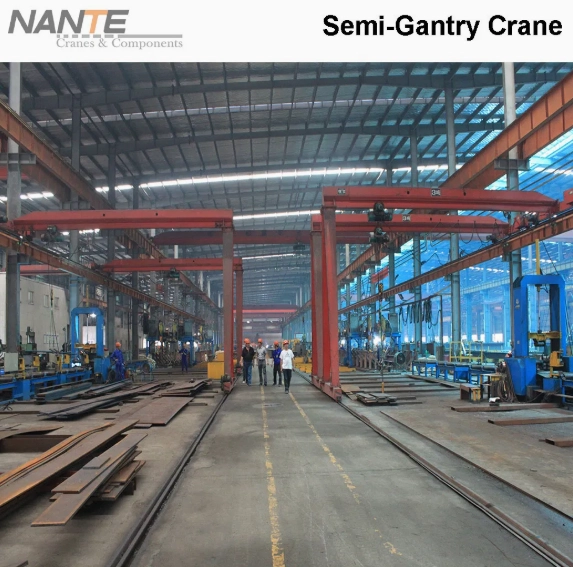How Safety Standards and Risk Control Define the True Value of Industrial Cranes
Date: 2025-11-14 Share:
Introduction
In manufacturing, logistics, construction, and heavy-industry operations, selecting an industrial crane is never just a cost decision—it’s a risk management decision. The reality remains: the cheapest crane is not the best investment—the safest, most compliant crane is.
As global supply chains expand, buyers increasingly require proof of industrial crane safety standards, crane risk control, and crane safety compliance to meet corporate ESG goals and insurance mandates. A safe crane is an investment that protects personnel, assets, and operational uptime.
Why Industrial Crane Safety Standards Matter
The Landscape of Global Standards
Industrial cranes operate in high-risk environments where any mechanical failure can have catastrophic results. That is why international safety frameworks such as ISO 9927 (inspection), EN 13001 (design principles), and FEM 1.001 (classification) have become benchmarks for manufacturers.
Compliance with these standards ensures structural integrity, mechanical reliability, and electrical safety—helping buyers reduce liability and ensure operational consistency across global projects.
From Standards to Risk Control
Safety standards translate into practical design requirements. A crane that adheres to global codes automatically integrates mechanisms for overload limitation, stability assurance, and emergency intervention. These systems convert theoretical compliance into tangible crane risk control and crane safety compliance, supporting safer workplaces and lower insurance exposure.
The Hidden Cost of Non-Compliant Cranes
Risks to People, Assets and Operations
Ignoring compliance introduces unacceptable risk. Structural failure, cable breakage, or uncontrolled motion can halt production for weeks. Beyond repair costs, the financial exposure includes legal claims, loss of reputation, and cancelled contracts due to non-compliance.
Why the “Cheapest Crane” May Cost More Over Its Life
Cranes built without certified materials or quality testing often degrade faster under fatigue. Their total cost of ownership (TCO) can double or triple over time due to frequent repairs and downtime. Safety-certified cranes, though initially more expensive, guarantee operational continuity and lower long-term costs.
Key Features to Assess for Crane Safety Compliance
Engineering & Design Features
Overload protection to prevent exceeding rated load capacity.
Limit switches ensuring motion stops before dangerous travel ends.
Emergency stop systems for rapid power isolation.
Precision-engineered structural components designed for long-term fatigue resistance.
Testing & Certification
100% dynamic and static load tests before shipment.
CE and ISO-certified production systems audited annually.
Documented traceability from raw material to final assembly.
Quality and Traceability
Material certificates, weld inspection records, and non-destructive test (NDT) reports stored for each unit.
Full audit trail supporting compliance verification during plant inspections.
Intelligent Safety Systems
Modern cranes increasingly integrate IoT-enabled monitoring, real-time load analysis, and condition diagnostics. Predictive maintenance analytics now form part of advanced crane risk control, allowing safety engineers to intervene before mechanical failure occurs.
Risk Control Process in Crane Procurement
Step 1: Define Application and Risk Profile
Determine load parameters, frequency of use, and environmental factors such as humidity, dust, or corrosion exposure. Each variable affects the crane’s classification and safety factor requirements.
Step 2: Evaluate Vendor Safety Systems
Choose suppliers that publish their testing protocols and maintain accredited laboratories. Review compliance certificates from third-party inspection bodies to confirm industrial crane safety standards are met.
Step 3: Verification and Acceptance Testing
Upon delivery, insist on load-testing demonstrations, electrical safety checks, and documentation reviews. These steps verify that the supplied crane matches its certification.
Step 4: Ongoing Risk Monitoring
Long-term safety requires regular inspection schedules, re-testing, and operator certification. Smart sensors on advanced cranes help capture performance data, ensuring continuous risk control over the asset’s lifecycle.
Global Compliance Trends Driving Crane Selection
Across the EU, the Middle East, and Asia-Pacific, compliance has evolved from a selling point into a procurement prerequisite.
Insurance companies increasingly demand certified cranes to reduce underwriting risk.
Multinational EPC contractors require suppliers to align with ISO and EN standards before tender qualification.
Government safety regulators perform random factory audits to confirm CE conformity.
For global buyers, verifying compliance at the manufacturing stage prevents downstream penalties or costly re-certification.
How Nante Crane Integrates Compliance into Every Design
Safety-Driven Engineering
Nante Crane, a trusted industrial crane manufacturer in China, embeds risk control in every stage of design and fabrication. Each crane undergoes finite-element analysis (FEA) for load simulation, followed by 100% load testing and inspection before shipment.
Certified Manufacturing & Testing
The company’s CE- and ISO-accredited processes ensure global compatibility with ISO, EN, and FEM standards. Every crane is supplied with complete documentation packages—traceable material certificates, welding inspection reports, and calibration data.
Smart Safety Systems
Nante’s cranes feature overload protection, anti-collision systems, limit switches, and emergency stop systems as standard. Optional intelligent modules enable remote diagnostics and predictive maintenance analytics, improving uptime and compliance reporting.
End-to-End Quality Traceability
All components—from hoists to electrical controls—are logged in a centralized database for traceability. Buyers benefit from verifiable compliance evidence, essential for safety audits or ISO-based plant certifications.
Buyer’s Checklist for Safe Crane Procurement
Confirm CE, ISO, EN and FEM compliance.
Request full load-testing certificates and material traceability reports.
Verify smart safety systems are integrated.
Ensure manufacturer provides installation supervision and operator training.
Review preventive-maintenance documentation for lifecycle assurance.
Conclusion
Safety and compliance are no longer optional—they define the true value of an industrial crane. A crane aligned with industrial crane safety standards, designed for crane risk control, and built for crane safety compliance ensures protection of people, productivity, and profit. The most valuable cranes are those engineered for reliability and verified through certification, testing, and intelligent monitoring.
About Nante Crane
Nante Crane is a globally recognized manufacturer and supplier of cranes and crane components, exporting to over 50 countries. Its range includes overhead cranes, gantry cranes, bridge construction cranes, and specialized lifting solutions for manufacturing, logistics, and infrastructure.
Through engineering innovation, compliance, and total quality control, Nante delivers cranes built for long-term performance and international safety assurance.
Partner with a Certified Industrial Crane Manufacturer
Procurement and safety teams seeking reliable, compliant lifting solutions can collaborate directly with Nante Crane—a CE- and ISO-certified industrial crane manufacturer and supplier.
Request compliance documentation, risk-assessment support, or product customization at www.nantecrane.com.
Invest in certified safety. Invest in long-term reliability. Partner with Nante Crane. Contact Nante Crane for free consultations on tailored solutions.
FAQ
What standards define global crane safety?
ISO 9927, EN 13001, and FEM 1.001 set essential parameters for design, testing and operation of industrial cranes.
How can compliance reduce operational risk?
Compliance ensures predictable performance, limits human error, and meets regulatory and insurance safety thresholds.
Why insist on 100% load testing?
It validates that the crane’s structure, hoist and braking systems perform safely under rated capacity.
What documents prove compliance?
CE certificate, ISO audit report, load-test record, material certificate, and inspection checklist.
How does Nante Crane maintain quality traceability?
Each crane component is tagged and recorded within an internal digital system, ensuring verifiable data for audits and long-term maintenance.





